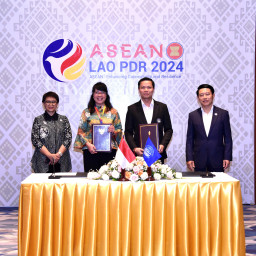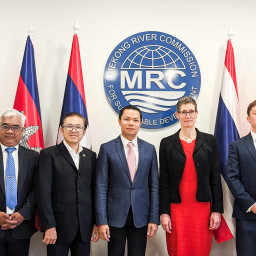Community involvement key to countering flood risks, says the MRC
Communities who live in the Mekong River Basin will significantly benefit from the improvements in flood forecasting and guidance that have been developed by the Flood Management and Mitigation Programme says the Mekong River Commission (MRC).
“Although they may be resource rich, most of the 60 million people of the basin who are farmers and fishers and who are poor, are highly vulnerable to floods. Floods endanger their lives, destroy their livelihoods and crops and exacerbate their living conditions,” said Jeremy Bird, CEO of the MRC Secretariat at an annual regional forum in Vientiane today of government agencies, researchers, NGOs and other interested groups working on Mekong Basin flooding.
“More engagement from communities vulnerable to flood risks and other disasters is very important because any flood planning measures and responses need to directly address the peoples' needs,” he added.
The MRC says the considerable experience of working on floods in its four Member Countries has demonstrated that a community-based approach to flood risk management and mitigation can help to fill the gap of the developed systems. Since 2005 the MRC flood programme has engaged 11 most flooded provinces in the Lower Mekong Basin in improving the capacities of authorities at all levels in developing and implementing flood preparedness programmes, community early warnings and emergency responses, all of which have contributed to the overall flood risk reduction efforts by the national governments.
“Better coordination in response to the impacts of recent disasters such as Typhoon Ketsana shows enhanced institutional capacity and confidence of local authorities. But, in order to sustain, flood preparedness and mitigation activities need to better reflect the needs of affected people and be integrated into local development plans,” said Hatda An Pich, Operations Manager of the MRC’s Regional Flood Management and Mitigation Centre (RFMMC) based in Phnom Penh, which is responsible for forecasting flooding on the mainstream of the Mekong and for a new flash flood guidance system in the river basin to be tested this year.
“The prerequisite for long-term involvement as well as for making sure that the activities are embedded firmly in government development plans is to get communities involved more. They need to feel that they own the system,” said Hatda.
One such MRC regional initiative to get potentially affected people more involved in flood preparedness has been undertaken to provide villagers in the flood prone areas with cell phones, flood information boards and training to use them and report localised floods to national flood forecasting agencies. The recorded data is sent back to the villagers who then publicise it on billboards at central locations in the floodplains and advertise any imminent flood threat via loudspeakers.
“This approach, where villagers monitor and measure water levels themselves has also been cost effective and relevant to local conditions,” said Hatda.
Floodplain villagers in the provinces now get up to two-day notice of any impending flood. This has enabled them to prepare for imminent flooding and evacuation, as well as to take measures to protect cattle and other livestock, as well as their properties. The experience will also help in the longer term in understanding the local flood patterns and provide assistance to villagers in designing more resilient irrigation systems as well measures to reduce risk, for example with crop selection.
The information gathered can also be used by Departments of Hydrology and River Works to develop maps and computerised simulation models for predicting when flash floods will be most likely to occur in remote areas, how people can adapt to these floods and how they can better plan land-use.
-ends-
Languages
Download this press release in:
Notes to Editors
Photos available on request
The 8th Annual Flood Forum will provide opportunities interviews with flood experts, to obtain regional and national views as well as experiences in countering Mekong floods and other disasters.
As well as discussing the importance of community focused approach to flood risk management and mitigation, including its application in the Lower Mekong Basin. Some discussion topics will include:
- To what extent has the MRC flood forecasting and flash flood guidance system been helpful in producing flood forecasts and early warnings in the Mekong River Basin?
- In addition to the people-centred approach to flood risk management and mitigation, what could be concrete measures that are crucial for a socio-economic and environmentally sound flood risk management?
- The importance of trans-boundary cooperation for managing floods and related issues;
- What are the changes caused by land-use and climate impact on flood management and how to cope with them?
The 2008 flood season in the Lower Mekong Basin saw rivers reach their highest levels since 1966 between the Chinese border and Vientiane/Nong Khai. Extensive flooding occurred in Lao PDR and Thailand, mainly in rural agricultural areas but also within urban areas. Parts of the city centre of Luang Prabang were flooded as well as areas on the outskirts of Vientiane and Nong Khai. More than US$ 135 million worth of damage was caused, with Thailand and Lao PDR bearing most of the brunt of this loss. In 2009, Ketsana alone caused loss of US$ 900 million of which the greatest proportion occurred in Viet Nam. Damage and loss costs in Cambodia were US$ 132 million.
The Regional Flood Mitigation and Management Centre gathers information from water monitoring systems all over the Mekong Basin, from Yunnan Province in China to the Delta in Viet Nam. Readings are collated and potential floods predicted. News and warnings are then sent out across the region, helping authorities and communities to prepare for events as early as possible. As the heart of the MRC Flood Management and Mitigation Strategy, the Centre also provides training and technology transfer to specialists in the four MRC Member States.
The MRC is the intergovernmental body responsible for cooperation on the sustainable management of the Mekong Basin whose members include Cambodia, Lao PDR, Thailand and Viet Nam. In dealing with these challenges, it looks across all sectors including sustaining fisheries, identifying opportunities for agriculture, maintaining the freedom of navigation, flood management and preserving important ecosystems. Superimposed on these are the future effects of more extreme floods, prolonged drought and sea level rise associated with climate change. In providing its advice, the MRC aims to facilitate a broad range of dialogue among governments, the private sector and civil society on these challenges.
For More Information
Mr Khy Lim, Communications Officer
Tel: +856 20 5622 8131
Email: khy@mrcmekong.org




